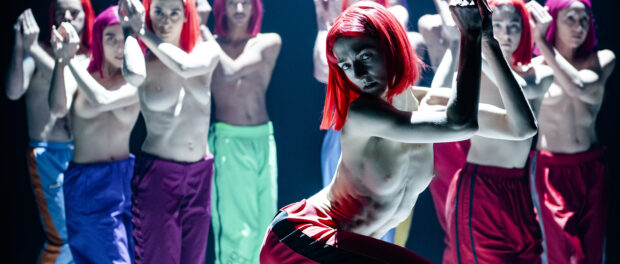Marie Chouinard’s “M”: animated by breath
Chouinard's latest work explores how the breath animates the body in an ode to life.
 Photo © Sylvie-Ann Paré. Dancers Motrya Kozbur, and in the background Adrian W.S Batt, Rose Gagnol, Clémentine Schindler, Jossua Collin Dufour, Valeria Galluccio, Paige Culley, Carol Prieur.
Photo © Sylvie-Ann Paré. Dancers Motrya Kozbur, and in the background Adrian W.S Batt, Rose Gagnol, Clémentine Schindler, Jossua Collin Dufour, Valeria Galluccio, Paige Culley, Carol Prieur.
Watching Marie Chouinard’s latest creation, “M,” is like having a fever dream where AI teaches cute mechanical dolls how to dance like humans. It’s simultaneously engrossing and off-putting, fascinating and annoying, too long but potentially endless.
The one-hour work is a serial riff on one idea: how does the breath, and the sounds it makes, animate the human body? Throughout, there is the ever-present acknowledgment that movement is mechanical, that the line between human and machine is in many ways a fine one.
The work opens with an electric boom as bright stage lights suddenly turn on, illuminating a bare stage, the wings exposed. The sound and lights give the impression that a machine has just been activated. But the ensuing few minutes transmit the peaceful feeling of the natural world: the sound of rain and chirping birds envelop four dancers who recline in various positions on the floor, lounging languorously. All topless, they wear shocking fuchsia wigs and neon coloured pants. They seem like tropical forest animals waiting out a gentle rain.
But then a fifth dancer enters and places a microphone on the stage. For the remainder of the work, a dozen dancers take turns approaching the mic, and moving to the intonation of short, repeated, wordless phrases. The sounds evoke small animals or children, or sometimes the insane, but also the quasi-mechanical. They are the sounds that malfunctioning 19th-century toys in a Scandinavian art film might make.
After each dancer intones their phrase, the sound snippet is repeated for several minutes to the accompaniment of an electronic soundtrack, and the dancers let the sound sequence move through their bodies, either in unity or in various group or solo configurations. The breath, the sound, the movements: there is no distinction between the three; together they form a unity.
At first the whole process is fascinating. The way that the breath and the sounds enervate the body makes total sense, in a hallucinatory sort of way. The bright, stark lighting highlights the exposed ribs, the muscles, the sinews; each movement is animalistic but also visibly mechanical. Whatever it is that animates bodies is shown to be both ethereal and concrete, simultaneously and inextricably of the mind/spirit and of the physical. The dancers come across not so much as human but rather as innocent animals or animated dolls.
The serial structure of the work, used on other occasions by Chouinard, felt a bit flat. It could have gone on forever, or for half the time. There were moments when I had had enough, but yet another dancer approached the mic and breathed a new pattern of breath and movements. I didn’t have any sort of emotional response, but rather the feeling of having entered into a wonky world where machines were trying to be human and humans were both trapped and brought to life by the mechanics of their bodies.
“M” by Marie Chouinard was at Theatre Maisonneuve from January 31 through February 4 as part of the 2023-23 Danse Danse season.
1 Comment on Marie Chouinard’s “M”: animated by breath
Comments are closed.






Check out Rissums Universal Robots and think it was written in the 1920s. We have come a long way.